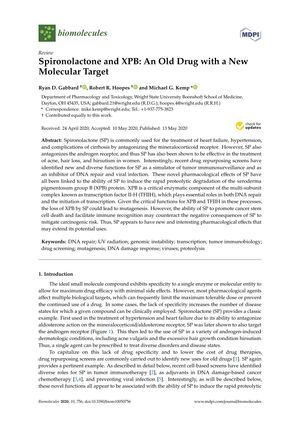Spironolactone and XPB: An Old Drug with a New Molecular Target
May 2020
in “
Biomolecules
”

TLDR Spironolactone, a heart and liver drug, has new uses including cancer treatment, viral infection prevention, and skin condition improvement.
The document from May 13, 2020, reveals that spironolactone (SP), a drug known for treating heart failure, hypertension, and cirrhosis, has been found to have new pharmacological roles. It can stimulate tumor immunosurveillance, inhibit DNA repair, and prevent viral infections by inducing the degradation of the XPB protein, which is crucial for DNA repair and transcription initiation. SP's ability to antagonize the androgen receptor also makes it effective for treating acne, hair loss, and hirsutism in women. The drug's impact on XPB protein levels is reversible and mediated by ubiquitination and the proteasome, which could enhance the effectiveness of DNA-damaging anti-cancer drugs and serve as an anti-viral compound. SP also reduces survivin expression in cancer cells, suppresses NF-kB and AP-1 signaling in cardiovascular research, and affects HIV transcriptional regulation. Topical applications of SP are being investigated for skin conditions, and spironolactone-loaded nanoparticles are being developed for improved therapeutic use. However, the potential risk of mutagenesis and carcinogenesis due to impaired DNA repair by XPB degradation is a concern, and further research is needed, especially regarding SP metabolism in the skin and the advised caution with UV exposure for those using high doses of SP.










